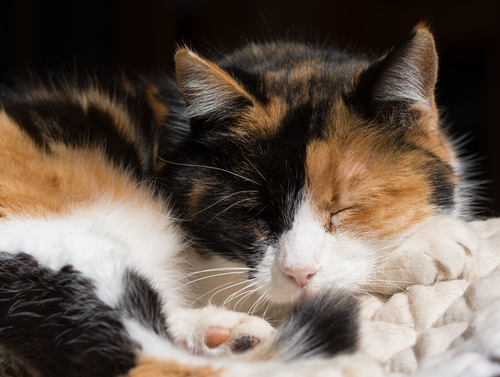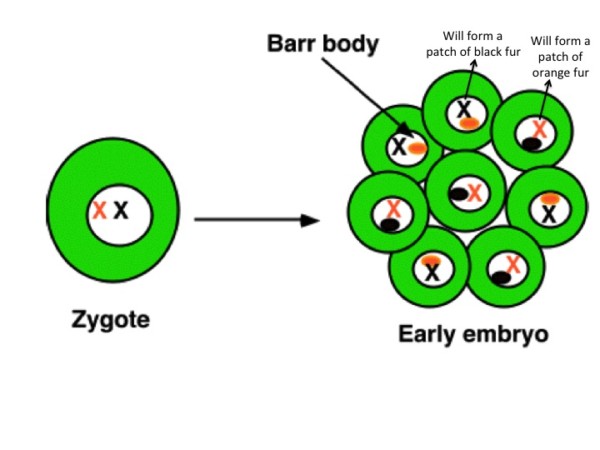 Shutterstock Image
Shutterstock Image
In order to appreciate the power of genetics, you only need to take a good look at a cat. Not just any cat - it has to be a calico, specifically.
The black and orange patches that define the coloring of a calico cat beautifully illustrate the genetic mechanism known as "dosage compensation."
You see, almost all calico cats are female which means that they have two X chromosomes in every cell. (1) A male cat with an XY could not make this same pattern of fur. And here's why...
Whether a cat (or human) is biologically male or female is dictated by which sex chromosome (X or Y) they got from their father's sperm. In most cases, there is an equal chance for either type of sperm to make it to the egg, which always has an X chromosome. And, since the sperm that fertilizes the egg also determines the sex, if a sperm carrying a Y wins the race, you are male. If it's an X, you are female. This is not the case for all animals, but, that is a topic for another article.
The Y chromosome has very few genes on it (only 72 that make proteins) and none of those genes is required for the cell to survive. This is clearly illustrated by all females, who obviously do just fine without any Y chromosomes. The Y chromosome is important in the process of becoming male. One of the genes on the Y chromosome is called the SRY (sex determining region Y) gene. SRY makes a protein that works to create male traits, for example, controlling the production of male hormones among other male-related things.
The X chromosome is a different story. It is large and has hundreds of genes on it, many of which are essential for cells to survive. Therefore, the X chromosome is required for all humans, not just females. One complication is that, males only have one X chromosome (XY) and females have two (XX.) However, females cannot survive if they have double the proteins made by the X chromosome. So, they need to compensate somehow for this imbalance.
There are different compensatory solutions to this predicament, which is species-dependant. For example, male fruit flies express the one copy of their X twice as much as female fruit flies, making up the difference that way.
Humans have the opposite strategy. Females shut down one of their Xs early on in the process of embryogenesis (when the fertilized egg (zygote) divides to form the cells that will eventually become a person) through a process called "X chromosome inactivation." The X that is inactivated is chosen randomly in each cell. It is inactivated through a process that slathers the chromosome with small RNA molecules, resulting in those genes not being expressed. The RNA molecules initiate other changes that lead to the X chromosome being condensed down into a small, dense, cluster of DNA (seen on the image below.) The inactivated X is now called a "Barr Body" named after Murray Barr, the person who first discovered the structure.
 image from amy.palamounta.in
image from amy.palamounta.in
But, what does this have to do with a calico cat?
In a calico cat, the gene that dictates fur color happens to be located on the X chromosome.
As shown on the illustration below, if the X chromosome carrying the gene for black fur gets inactivated, that cell will instead create orange fur. If the X chromosome carrying the gene for orange fur is inactivated, that cell will create black fur. Because the Xs that are inactivated are chosen at random, the pattern on each calico cat is distinct from another.
How does this process result in the black and orange patches? In order to understand the patches, we have to think about when the process of X chromosome inactivation happens and what each of those cells is going to do, after the X is inactivated. As shown in the picture, the X chromosome is inactivated when there are only about eight cells in the embryo. Each of these eight cells, after the X inactivation, continue to divide, over and over again, to create the millions of cells that make up the entire cat. Because the inactivation process occurs at this early stage of development, each cell that stems from one of the original eight cells, will have that same X inactivated. So, the cell shown below that "will form a patch of black fur" will do so because all of the cells that come from that one cell will have the same X inactivated. Instead of just one cell that will make black fur, there will be millions of cells expressing black fur in the same location, creating a patch.
 Image modified from www2.estrellamountain.edu/faculty/farabee/biobk/BioBookgeninteract.html
Image modified from www2.estrellamountain.edu/faculty/farabee/biobk/BioBookgeninteract.html
The calico cat is one example of an important genetic process that is incredibly fascinating at the same time. Indeed, this complicated process still has a lot of unanswered questions. But, for now, knowing the basics, I dare you to ever look at a calico cat the same way again.
Notes:
(1) Rarely, a cat is born with two X chromosomes and one Y. (This also happens in humans and is called Klinefelter syndrome.) Those cats are male due to the presence of the Y chromosome, but can also make the calico pattern due to the presence of two X chromosomes.



